Tag archives: astronomy
Hubble at 25, Star Trek selfies on the ISS, Wu-Tang Clan physics and more
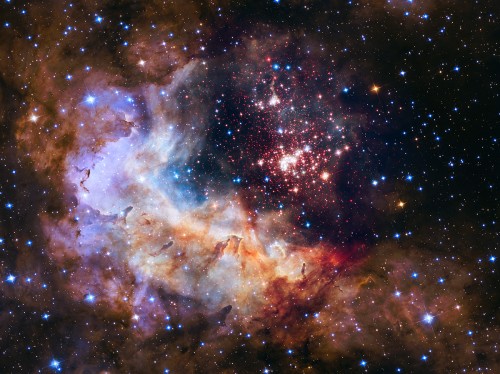
Shine on: Hubble’s official 25 anniversary image of the Westerlund 2 cluster.
(Courtesy: NASA, ESA, (STScI/AURA), A. Nota (ESA/STScI), Westerlund 2 Science Team)
By Tushna Commissariat
25 years ago today, the ESA/NASA Hubble Space Telescope (HST) was launched aboard the Discovery space shuttle and since then, it has changed the face of observational astronomy as we know it; taking millions of people worldwide from their homes to the most distant and far-flung reaches of the universe and the imagination. The telescope has also been instrumental in some of the biggest, Nobel-prize-winning discoveries in physics in the past two decades, including that of the accelerating expansion of the universe. The stunning image above of the giant cluster of nearly 3000 stars dubbed “Westerlund 2” was especially released yesterday to celebrate Hubble’s 25th anniversary. The stellar nursery is difficult to observe because it is surrounded by dust, but Hubble’s Wide Field Camera 3 peered through the dusty veil in near-infrared light, giving astronomers a clear view of the cluster. Once you are done staring in awe at the image, watch the short video below, put together by NASA on the HST’s lifetime.
Isaac Newton’s Good Friday, art meets physics and our favourite April Fool gags
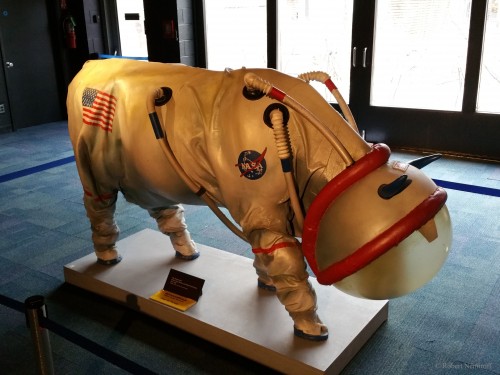
Suiting up for the Moon – an artwork aptly titled “Mooooonwalk”. (Courtesy: APOD/ Robert Nemiroff/Michigan Technological University)
By Hamish Johnston and Tushna Commissariat
As it’s Good Friday today, it can only mean that this week’s Red Folder will include a selection of the best physics-related April Fool jokes from earlier this week. Fermilab’s daily e-bulletin Fermilab Today had an entire joke edition up in the morning – their lead story was probably our favourite as the lab announced its new breakfast cereal dubbed “Neutrin-Os”, but their new day spa sounds pretty good too. CERN went for the funny if slightly obvious Star Wars joke, confirming the existence of the Force, but a slightly more subtle joke came earlier in the week from CERN Bulletin, which ran a story about CERN’s computer-security department handing out prizes for best password – we are still not quite sure if they were joking or not! Astronomy Picture of the Day had a truly fantastic image (see above) of a Lunar Grazing Module described as a “multipurpose celestial bovine containment system”.
Bristol marvels at awe-inspiring solar eclipse
By Tushna Commissariat and James Dacey
The south-west of England is not exactly known for its sunny skies at this time of year, so many of us in Bristol – home to Physics World HQ – had steeled ourselves to miss out on today’s solar eclipse, which coincidently is on the first day of spring. So, we were rather overjoyed when the Sun shone through the sparse cloud cover for nearly an hour of the celestial treat. While today’s eclipse was technically visible to anyone in North Africa and Europe, totality was only visible to those lucky few who happened to be on the Faroe Islands (where it was actually cloudy for most of the time) and in Svalbard in northern Norway. Here in Bristol, the eclipse peaked at about 9.30 a.m., when 87% of the Sun’s light was blocked by the Moon.
Guide to the solar eclipse
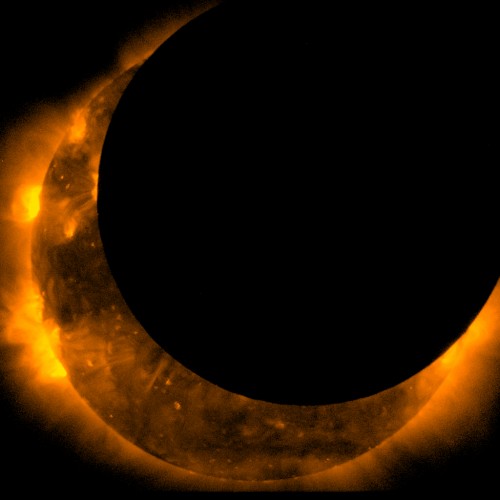
Solar eclipse of 2012, which darkened parts of the US and south-east Asia. (Courtesy: JAXA/Hinode)
By James Dacey
On Friday, our old friend the Moon will swing by to remind us that she’s not just there to reflect the Sun’s light; she can sometimes block it out too. A total solar eclipse will be visible to those lucky few people living in the Faroe Islands or the Norwegian archipelago of Svalbard. Many others across Europe, North Africa and Russia will be treated to the (almost as good) spectacle of a partial solar eclipse.
View all posts by this author | View this author's profile
Decoding the dark arts of Interstellar's black hole
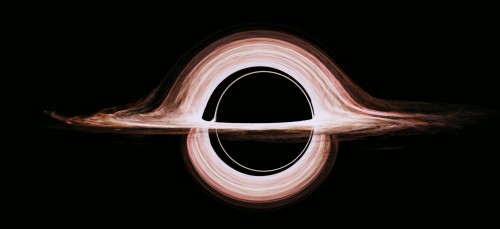
A moderately realistic, gravitationally lensed accretion disc around a black hole, created by Double Negative artists. (Courtesy: Classical and Quantum Gravity)
By Tushna Commissariat
In recent years, science and science fiction have come together in cinema to produce a host of rather spectacular visual treats, the best of the lot being Christopher Nolan’s epic Oscar-nominated film Interstellar. That actual science has played a major role in film is pretty well known, thanks to the involvement of theoretical physicist Kip Thorne, who was an executive producer for the project. But in a near-cinematic plot twist, it has emerged that Thorne’s work on trying to develop the most accurate and realistic view of a supermassive black hole “Gargantua” has provided unprecedented insights into the immense gravitational-lensing effects that would emerge if we were to view such a stellar behemoth.
View all posts by this author | View this author's profile
Flying high in Baltimore
By Susan Curtis in Baltimore, US
After two days of getting to grips with biophysics – see here and here for my experiences – I was ready for a change of scene. And a visit to the Space Telescope Science Institute (STScI), co-located with the Johns Hopkins University in Baltimore but operated on behalf of NASA, was just what I needed.
The STScI is home to many of the scientists and engineers who made the Hubble Space Telescope possible, and who have been working for many years to design the optics and instrumentation for its successor – the James Webb Space Telescope (JWST), which is due to be launched in 2018. The institute also runs the science operations for Hubble and soon will for the JWST, providing software tools for astronomers to make their observations and processing the raw data acquired by the onboard instruments to make it ready for scientific analysis.
UK to open its first ‘pub observatory’
By Michael Banks
Fancy having a few pints while gazing at the stars? Well soon you will be able to, thanks to a new initiative at the Barge Inn at Honeystreet on the banks of the Kennet and Avon canal in Wiltshire, UK.

The Barge Inn. (Courtesy: The Barge Inn)
Known as “the most famous pub in the universe”, the boozer is already a favourite among UFO aficionados and crop-circle hunters.
But now the free house, which has its own brewery making beers such as Alien Abduction and Roswell, is turning to the stars by creating the UK’s first pub observatory.
The 205-year-old rural pub recently had planning permission accepted by Wiltshire county council for a 6 m-tall domed observatory to be constructed in the pub’s neighbouring campsite.
Dubbed the Honeystreet Observatory, it will be able to accommodate groups of about twenty people and will feature a Celestron 14″ 1400 Pro telescope. The images from the telescope will also be relayed onto screens in the pub.
It is hoped that the observatory will boost visitors, particularly in the winter months when there is less daylight and more time for observations – and drinking, of course.
“We had originally intended to build the observatory next year but due to the great
response since gaining planning consent, construction will commence next
month.” pub landlord Ian McIvor told physicsworld.com.
And will it be a good idea to mix alcohol with astronomy, particularly with the tricky ascent to the telescope? “You would be amazed at what some of the pub’s customers can accomplish after a few pints,” adds McIvor. “Gazing at the stars and falling down the stairs is a regular activity, so we think it will be business as usual!”
View all posts by this author | View this author's profile
Louise Mayor bags European astronomy journalism prize
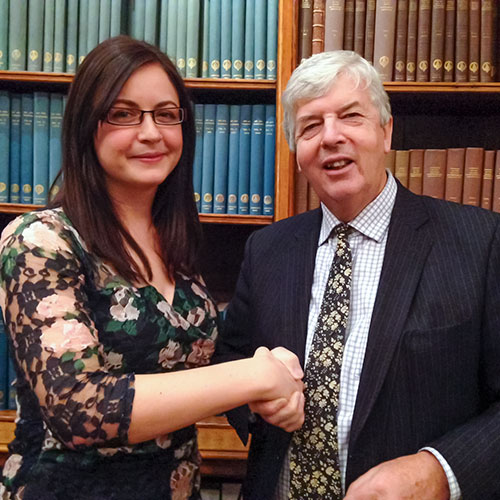
Andrew Taylor of the Science and Technology Facilities Council congratulates Louise Mayor on winning the European Astronomy Journalism Prize 2014. (Courtesy: ESO/STFC)
By Matin Durrani
If you think that writing a great feature article about physics is easy, think again. You want something that’s pitched at the right level for the audience. You’ve got to avoid jargon and explain technical terms where necessary. You can’t go on and on – you’re not trying to rewrite Wikipedia.
Most importantly, you need to tell a good story and say something new, different and intriguing. And remember, your readers could switch off at any point, so the article has to be well written, flow well from point to point, have plenty of colour and, ideally, have some pay-off or punch-line at the end. No point just trailing off into nothingness. Oh, and good pictures, headlines and captions are a must.
So I’m sure you’ll join me in congratulating my colleague Louise Mayor – features editor of Physics World magazine – who has won this year’s European Astronomy Journalism Prize for an article she wrote for the October 2014 edition of the magazine. Her winning article is entitled “Hunting gravitational waves using pulsars” and looks at efforts to detect gravitational waves using radio telescopes to observe distant pulsars.
Space bonanza to land in Manchester

The Age of Starlight will catch both the eyes and the minds of the audience. (Courtesy: ESO/P D Barthel)
By James Dacey
Whatever punters make of the Manchester International Festival (MIF) next year, they certainly won’t be able to accuse it of thinking small. Among the first commissions announced today is a “world-first show about the origin of the universe and everything within and without it”.
The Age of Starlight will be presented by the physicist and TV personality Brian Cox, who will tell the story of the unlikely events that have led to our existence. Details of the show are still scarce but we do know that the space bonanza will feature computer-generated imagery created by the Oscar-winner Tim Webber and the special-effects team behind the film Gravity. The event will be brought to life with technologies developed by Magic Leap, a Florida-based IT company that specializes in “magical” computing solutions.
View all posts by this author | View this author's profile
Last chapter in Rosetta’s Philae lander story…for now
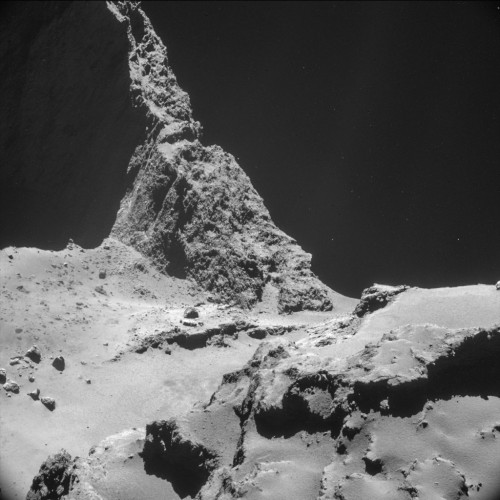
Strange new world: Image of comet 67P taken by Rosetta’s NAVCAM from 10km away.
(Courtesy: ESA/Rosetta/NAVCAM, CC BY-SA 3.0 IGO)
By Tushna Commissariat
Last week was exciting and exhausting for anyone involved in space exploration and astronomy, after scientists working on the Rosetta mission of the European Space Agency (ESA) made history when their “Philae” module touched down safely on the surface of comet 67P/Churyumov–Gerasimenko. But soon after celebrating Philae’s successful landing, a dramatic story unfolded. With a bumpy triple landing, harpoons that did not fire and tether the probe, as well as a final resting spot that lay in the shadows, which meant its solar panels received very little sunlight, Philae’s tumultuous story captivated the interest of thousands of people across the globe.
In the early hours of Saturday morning, as Philae’s batteries slowly drained of power, thousands mourned. “So much hard work..getting tired…my battery voltage is approaching the limit soon now,” Tweeted the Philae crew, and yet, the lander’s story was ultimately happy and successful. Although it spent only 57 “active” hours on the comet, ESA mission scientists were happy to report that the lander had indeed completed the entirety of its primary science mission.
View all posts by this author | View this author's profile